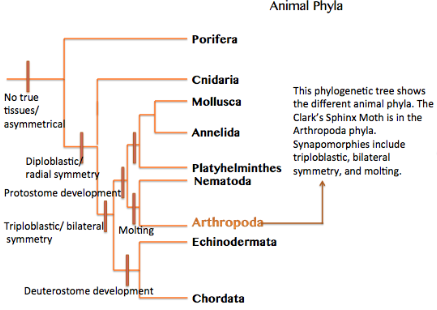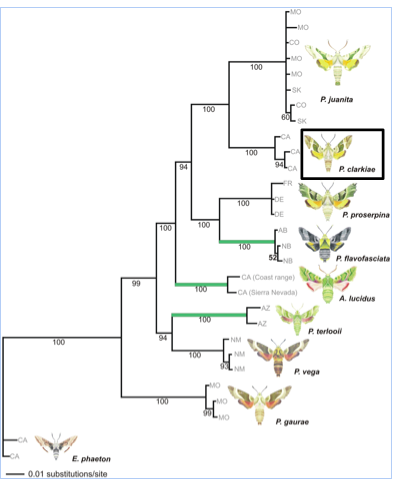Classification
Every individual organism living on this
plant varies from another in their shape, color, size, habitat, and
numerous other factors. This is significantly due to their
classification. Each organism has a domain, clade, kingdom, phylum,
class, order, family, genus, and species associated with it. As you
look at the taxonomy
of organisms, it becomes less broad and more specific from domain to
species. To put it
into perspective, there are only three domains in which organisms
fall into while there are roughly 8.7 million species in the world
(Mora et al. 2011).

Taxonomic Classification
Domain: Eukarya
Clade: Opisthokonta
Kingdom: Animals
Phylum: Arthropod
Class: Insecta
Order: Lepidoptera
Family: Sphingidae
Genus: Proserpinus
Species: Clarkiae
Domain:Eukarya
The Clarks Sphinx Moth is in the Eukarya domain, contrast to Bacteria and
Archaea, because it has mitochondria, a nucleus, and membrane-bound
organelles.
Clade: Opisthokonta
Members in the Opisthokonta clade, like this moth, have a
synapomorphy of having posterior flagella.
Kingdom: Animals
Opisthokonta is broken down into three kingdoms: Fungi,
Choanoflagellates, and Animals. Moths are certainly not fungi or
choanoflagellates and we all know that moths are animals. All
animals are multicellular organisms, consumers, have the ability to
move, and can reproduce.
Phylum: Arthropod
Arthropods consist of crustaceans (crabs and lobsters), insects, and
arachnids (spiders), therefore the moth is considered an Arthropod.
Synapomorphies of Arthropods include being
triploblastic, having bilateral symmetry,
molting
(exoskeletons), and consisting of segmented bodies.
Class: Insecta
The Insecta class contains all the insects in the world. To learn
more about the Insecta and other classes of Arthropods, click
here. This class
is typically seperated into twenty-nine orders (Dreees and Jackman
1999). The
orders are then broken down into different families using physical
characteristics to compartmentalize the organisms.
Order: Lepidoptera
One of the twenty-nine orders in this class is Lepidoptera.
Lepidoptera organisms from all other insects can be identified by
their two sets of scale-covered wings (EOL Encyclopedia of Life 2010).
The scales on their wings are crucial because it protects them from
predators, enabling them to camouflage their bodies to adapt to
their environment or mimic other organims the predator would not be
as interested in (Science Direct 1998). If organisms did not
have scale-covered wings, they would be more susceptible to
predators and harm, therefore
 lowering their
fitness. Lepidoptera,
containing all butterflies and moths, is one of the most familiar
and diverse orders in the world. They make up one of the four
largest groups of Insecta. If you are interested in seeing pictures
and learning more about the orders of insects, go to this
link.
lowering their
fitness. Lepidoptera,
containing all butterflies and moths, is one of the most familiar
and diverse orders in the world. They make up one of the four
largest groups of Insecta. If you are interested in seeing pictures
and learning more about the orders of insects, go to this
link.
Family: Sphingdae
Organisms in this family are frequently misktaken for hummingbirds,
hawk moths, or sphinx. Compared to other moths in this family, they
are strong and can fly fast. Their bodies are medium to large sized
and some species have wingspans of five or more inches long.
Organisms in this family actively search for their food at dusk (U.S.
Geological Survey 2012).
Genus:
Proserpinus
The Clarks Sphinx Moth's genus name is Proserpinus.
"Proserpina" is a form of the name "Persephone" from Greek
mythology. Proserpina, in Latin, means "to emerge" which makes sense for moths
because they disappear and emerge all the time (The Meaning of the
Name 2014).
Species: Clarkiae: Clark's Day Sphinx Moth
Clarkiae is Latin for "of Clarkia." Clarkia is a genus in
the Onagracaea plant family which are a major food source for these
moths. The moth was given this species name because it was named
after the famous explorer of the Lewis and Clark Expedition, William
Clark. The name Sphinx is believed to have been chosen by Carl Linnaeus, a famous
physician and botanist from Sweden, around the year 1758. He focused on classifying
organisms into genera and species and eventually established the
Binomial Nomenclature
(Campbell and Reece 2008). He named it the Sphinx Moth because when
the developing larvae is starled, it instintively raises up its head
and bends its body to appear bigger; somewhat resembling an Egyptian
Sphinx (Messenger 1997).
Personally, I think that is a stretch in developing its name but
Linnaues, being the worldly intellect he was, definitively chose it. How can I criticize Linnaues, the
man who set the foundations of the modern binomial naming system of
organisms that all scientists use today?
If you are interested in learning more about Carl Linnaeus and the
classification of organims in general, click
here.
To find out some more awesome information
about the Clark's Sphinx Moth, go onto the
habitat and geography page! Otherwise,
click back to home.